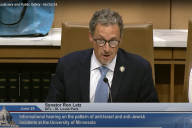You have /5 articles left.
Sign up for a free account or log in.
No critic would include the 2006 campus comedy Accepted in the pantheon of classic college movies. No one would confuse it with Mike Newell’s Mona Lisa Smile, Alan J. Pakula’s The Sterile Cuckoo, John Singleton’s Higher Learning, Spike Lee’s School Daze, or Curtis Hanson’s Wonder Boys. It doesn’t even rank in humor or sentiment with Back to School, Love Story, Monsters University, or Revenge of the Nerds.
Yet, Accepted, one of many Animal House knock offs, nevertheless points to some of the inadequacies of conventional college education: how colleges reinforce class divisions, undermine too many young people’s self-confidence and self-esteem, and fail to engage students’ passions.
Accepted’s ramshackle plot centers on a group of admissions rejects who create their own college – the South Harmon Institute of Technology -- in a former psychiatric hospital. When hundreds of academic rejects enroll in the school -- the college website says “acceptance is just a click away” -- the friends must create their own curriculum. Combining the philosophies of Jean-Jacques Rousseau and John Dewey, the students, an oddball assortment of social misfits, teach and take whichever courses they want, and, in the process, acquire essential knowledge, obtain valuable skills, and learn significant life lessons.
The film’s message is a simple one, but one that bears emphasis: That universities could do a better job harnessing students’ curiosity and intellectual passion and capitalizing on many faculty members’ creativity and desire to transform students’ lives.
Accepted’s answer is to transform students into teachers and involve them meaningfully in their own learning.
Many individual faculty members ask students to lead discussions or deliver brief presentations, and some deploy students as peer tutors. But only rarely are students treated as co-teachers. Opportunities for undergraduates to engage in independent research have certainly increased, but with the exception of the small number of maker spaces that are largely confined to Engineering and Business colleges, students are rarely treated as partners in course design and development.
I can personally attest to the value of engaging students as learning architects. In developing an activity-based U.S. history survey, students served as instructional designers, simulation producers, curators of audio and visual resources, and participants in assessment development. They and I engaged in frequent discussion. The students reported learning more about history from this experience than sitting in a classroom.
Can this model be scaled?
One answer might be to create an island of innovation within a larger university, freed from many of the conventions that govern much of academic life. To be provocative, we might call this a “charter college.” Like a charter school – a publicly funded institution that operates free of many of the state regulations – a charter college might serve as a laboratory for experimentation with new educational models, including those that reimagine curriculum design, pedagogy, scheduling, activities, assessments, requirements, and the student experience.
Most large research institutions have already created a third space. Usually, however, this takes the form of an honors college that give high achieving students access to small interdisciplinary seminars and co-curricular experiences associated with liberal arts colleges. The pedagogy and indeed the course content, however, tend to be highly traditional.
A handful of institutions have gone further. During the 1990s, a number of conservative-leaning foundations and think tanks proposed the idea of a charter college given institutional autonomy in terms of admissions, tuition, and tenure policies. One campus, St. Mary’s College of Maryland, a public liberal arts college, served as a poster child for the charter idea.
But imagine a college within a university that was a true innovation hub. Willing faculty members might experiment with a more coherent, thematically unified curricula or with experiential learning or embrace a co-op like “earn to learn” approach. Or they might build a curriculum in which the students and the faculty create instructional resources and learning tools.
Much of the innovation that takes place on academic campuses occurs within individual classrooms, greatly limiting the impact of new ideas. The charter college idea, in contrast, would encourage cross-disciplinary teams of faculty to reengineer entire degree pathways and student experiences at a much greater scale.
When Hollywood goes to the movies, the plots generally ignore academics and focus largely on campus romances, pranks, parties, football heroics, fraternity and sorority subcultures, and the college class divide as working-class students struggle for acceptance. To a disturbing extent, students, too, report that their most memorable learning experiences take place outside the classroom. Couldn’t we make the academic experience as immersive, intense, and meaningful as what too many students experience in co-curriculars and extra-curriculars?
Steven Mintz is Executive Director of the University of Texas System's Institute for Transformational Learning and Professor of History at the University of Texas at Austin.







